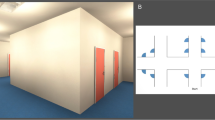Abstract
In this paper, we use computational tools (Cipresso P, Matic, A, Giakoumis D, Ostrovsky Y (2015) Advances in computational psychometrics. Comput Math Methods Med. Article ID 418683. https://doi.org/10.1155/2015/418683.5) to explore human navigation through an example of a visuomotor spatial memory locomotor task, the Walking Corsi task (WCT) variant from a well-known table test known as the Corsi Block Tapping task [(CBT) [2] and [15]. This variant was performed using the “Virtual Carpet” ™ experimental setup. The subjects had to memorize a succession of the position of targets projected on the ground and reproduce sequences of 2 to 9 targets by walking to each. The trajectory of the head was recorded and processed from a kinematic point of view. Generic tools that computational data analytics provides and through computer simulations by replicating visually this data allowed categorization of the different features of the behavior of the subjects providing a new powerful tool for both normal and pathological behavior characterization.
Access this chapter
Tax calculation will be finalised at checkout
Purchases are for personal use only
Similar content being viewed by others
References:
Cipresso P, Matic, A, Giakoumis D, Ostrovsky Y (2015) Advances in computational psychometrics. Comput Math Methods Med. Article ID 418683. https://doi.org/10.1155/2015/418683.5
Tedesco M, Bianchini F, Piccardi L, Clausi S, Berthoz A, Molinari M, Guariglia C, Maria L (2017) Does the cerebellum contribute to human navigation by processing sequential information? Neuropsychology 31. https://doi.org/10.1037/neu0000354
Montello D, Sas C (2006) Human factors of wayfinding in navigation. International encyclopedia of ergonomics and human factors. https://doi.org/10.1201/9780849375477.ch394
Irmischer I, Clarke K (2018) Measuring and modeling the speed of human navigation. Cartogrph Geogr Inf Sci 45:177–186. https://doi.org/10.1080/15230406.2017.1292150
Belmonti V, Cioni G, Berthoz A (2016) Anticipatory control and spatial cognition in locomotion and navigation through typical development and in cerebral palsy. Dev Med Child Neurol 58(Suppl 4):22–27. https://doi.org/10.1111/dmcn.13044
Corsi PM (1998) Human memory and the medial temporal region of the brain (Ph.D.) McGill University (1972). Berch DB, Krikorian R, Huha EM (1998) The Corsi block-tapping task: methodological and theoretical considerations. Brain Cogn 38(3):317–338. https://doi.org/10.1006/brcg.1998.1039
Meilinger T, Berthoz A, Wiener JM (2011) The integration of spatial information across different viewpoints. Memory Cogn 39:1042–1054. https://doi.org/10.3758/s134210110088-x
Hicheur H, Pham QC, Arechavaleta G, Laumond JP, Berthoz A (2007) The formation of trajectories during goal-oriented locomotion in humans. I. Stereotyped behavior. Eur J Neurosci 26(8):2376–2390. https://doi.org/10.1111/j.14609568.2007.05836.x
Pham QC, Hicheur H, Arechavaleta G, Laumond JP, Berthoz A (2007) The formation of trajectories during goal-oriented locomotion in humans. II. A maximum smoothness model. Eur J Neurosci 26(8):2391–2403. https://doi.org/10.1111/j.14609568.2007.05835.x
Pham Q (2014) A general, fast, and robust implementation of the time-optimal path parameterization algorithm. In: IEEE Trans Robot 30(6):1533–1540. https://doi.org/10.1109/TRO.2014.2351113
Kang MJ, Kim SY, Na DL et al. (2019) Prediction of cognitive impairment via deep learning trained with multi-center neuropsychological test data. BMC Med Inform Decis Mak 19:231. https://doi.org/10.1186/s12911-019-0974-x
Gorriz J, Ramírez J, Ortiz A, Martínez-Murcia, F, Segovia F, Suckling J, Leming M, Zhang Y-D, Álvarez-Sánchez J, Bologna G, Bonomini M, Casado F, Charte D, Charte F, Contreras R, Cuesta-Infante A, Duro R, Fernández-Caballero A, Fernandez E, Ferrández J (2020) Artificial intelligence within the interplay between natural and artificial Computation: advances in data science, trends and applications. Neurocomputing. https://doi.org/10.1016/j.neucom.2020.05.078
What Is Synthetic Data? | Unite.AI. https://www.unite.ai/what-is-synthetic-data/
Cipresso P, Serino S, Riva G (2016) Psychometric assessment and behavioral experiments using a free virtual reality platform and computational science. BMC medical informatics and decision making 16:37. https://doi.org/10.1186/s12911-016-0276-5
Corsi PM (1972) Human memory and the medial temporal region of the brain (Ph.D.). McGill University
Piccardi L, Iaria G, Ricci M, Bianchini F, Zompanti L, Guariglia C (2008) Walking in the Corsi test: which type of memory do you need? Neurosci Lett 432:127–131. https://doi.org/10.1016/j.neulet.12.044
Piccardi L, Leonzi M, D’Amico S, Marano A, Guariglia C (2014) Development of navigational working memory: evidence from 6- to 10-year-old children. Br J Dev Psychol 32:205–217. https://doi.org/10.1111/bjdp.12036
Perrochon A, Kemoun G, Dugué B, Berthoz A(2014) Cognitive impairment assessment through visuospatial memory can be performed with a modified walking Corsi test using the ‘Magic Carpet’. Dementia Geriatric Cogn Disord Extra 4:1–13. https://doi.org/10.1159/000356727
Berthoz A, Zaou, M (2015) New paradigms and tests for evaluating and remediating visuospatial deficits in children. Dev Med Child Neurol 57(Suppl 2):15–20. https://doi.org/10.1111/dmcn.12690
Elgendy N, Elragal A (2016) Big data analytics in support of the decision-making process. Procedia Comput Sci 100:1071–1084. https://doi.org/10.1016/j.procs.2016.09.251
Kang MJ, Kim SY, Na DL et al. (2019) Prediction of cognitive impairment via deep learning trained with multi-center neuropsychological test data. BMC Med Inform Decis Mak 19:231. https://doi.org/10.1186/s12911-019-0974-x.
Acknowledgments
We thank Dr. Bernard Cohen, Paris France, to let us use the preliminary test data obtained in cooperation with him to test the present method to evaluate its validity for the use of patient assessments.
Author information
Authors and Affiliations
Corresponding author
Editor information
Editors and Affiliations
Rights and permissions
Copyright information
© 2021 The Author(s), under exclusive license to Springer Nature Switzerland AG
About this paper
Cite this paper
Annaki, I. et al. (2021). Computational Analysis of Human Navigation Trajectories in a Spatial Memory Locomotor Task. In: Motahhir, S., Bossoufi, B. (eds) Digital Technologies and Applications. ICDTA 2021. Lecture Notes in Networks and Systems, vol 211. Springer, Cham. https://doi.org/10.1007/978-3-030-73882-2_22
Download citation
DOI: https://doi.org/10.1007/978-3-030-73882-2_22
Published:
Publisher Name: Springer, Cham
Print ISBN: 978-3-030-73881-5
Online ISBN: 978-3-030-73882-2
eBook Packages: Intelligent Technologies and RoboticsIntelligent Technologies and Robotics (R0)




